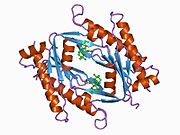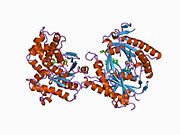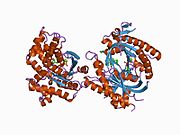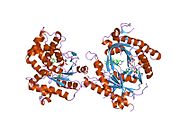Biology:ADCY2
 Generic protein structure example |
Adenylyl cyclase type 2 is an enzyme typically expressed in the brain of humans, that is encoded by the ADCY2 gene.[1][2] It belongs to the adenylyl cyclase class-3 or guanylyl cyclase family because it contains two guanylate cyclase domains.[3] ADCY2 is one of ten different mammalian isoforms of adenylyl cyclases. ADCY2 can be found on chromosome 5 and the "MIR2113-POU3F2" region of chromosome 6, with a length of 1091 amino-acids. An essential cofactor for ADCY2 is magnesium; two ions bind per subunit.[3]
Structure
Structurally, ADCY2 are transmembrane proteins with twelve transmembrane segments. The protein is organized with six transmembrane segments followed by the C1 cytoplasmic domain. Then another six membrane segments, and then a second cytoplasmic domain which is called C2. The important parts for function are the N-terminus and the C1 and C2 regions. The C1a and C2a subdomains are homologous and form an intramolecular 'dimer' that forms the active site.
This structure displays significant homology with human brain adenylyl cyclase 1(HBA C1 or ADCY1) in the highly conserved adenylyl cyclases domain found in the 3’ cytoplasmic domain of all mammalian adenylyl cyclases. Outside this domain homology is not similar suggesting that this corresponding mRNA originates from a different gene. In situ hybridization confirms a heterogeneous population of adenylyl cyclase mRNAs is expressed in the brain.[4]
Function
This gene encodes a member of the family of adenylyl cyclases, which are membrane-associated enzymes that catalyze the formation of the secondary messenger cyclic adenosine monophosphate (cAMP) from ATP. ADCY2 has also been found to accelerate phosphor-acidification, along with glycogen synthesis and breakdown.[5] This enzyme is insensitive to Ca2+/calmodulin, and is stimulated by the G protein beta and gamma subunit complex.[2] Therefore, ADCY2 is highly regulated by G-proteins, calcium, calmodulin, pyrophosphate, and post-translational modifications.
Recently, it has been discovered that ADCY2 can activated by a Raf kinase-mediated serine phosphorylation.[6] In aggregate, Raf kinase associates with adenylyl cyclases and is isoform-selective, which includes adenylyl cyclase type 2. In human embryonic kidney cells, ADCY2 is stimulated by activation of Gq-coupled muscarinic receptors through protein kinase C (PKC) to generate localized cAMP. Once the agonist binding to the Gq-coupled muscarinic receptor, A-kinase-anchoring protein (AKAP) recruits PKC to activate ADCY2 to produce cAMP. The cAMP formed is degraded by phosphodiesterase 4 (PDE4) activated by an AKAP-anchored protein kinase A.[7]
Clinical significance
Polymorphisms of the ADCY2 gene have been associated with COPD and lung function.[8]
Perturbations in adenylyl cyclase activity have been implicated in alcohol and opioid addiction and is associated with human diseases, including thyroid adenoma, Anthrax, precocious puberty in males and chondrodysplasia punctata diseases.[9] During these diseases, ADCY2 undergoes a super-related pathway where protein kinase A (PKA) activation occurs in glucagon signaling and IP3 signaling. This enzyme may play a role in bipolar disorder along with other brain-expressed genes including NCALD, WDR60, SCN7A, and SPAG16.[10]
Interactive pathway map
References
- ↑ "Different chromosomal localization of two adenylyl cyclase genes expressed in human brain". Human Genetics 90 (1–2): 126–30. Dec 1992. doi:10.1007/BF00210755. PMID 1427768.
- ↑ 2.0 2.1 "Entrez Gene: ADCY2 adenylyl cyclase 2 (brain)". https://www.ncbi.nlm.nih.gov/sites/entrez?Db=gene&Cmd=ShowDetailView&TermToSearch=108.
- ↑ 3.0 3.1 "Adenylate cyclase type 2". UniProt Consortium. https://www.uniprot.org/uniprot/Q08462#section_comments.
- ↑ "Different chromosomal localization of two adenylyl cyclase genes expressed in human brain". Human Genetics 90 (1–2): 126–30. Sep–Oct 1992. doi:10.1007/BF00210755. PMID 1427768.
- ↑ "Molecular cloning, sequence identification, and gene expression analysis of bovine ADCY2 gene". Molecular Biology Reports 41 (6): 3561–8. Jun 2014. doi:10.1007/s11033-014-3167-9. PMID 24797538.
- ↑ "Raf kinase activation of adenylyl cyclases: isoform-selective regulation". Molecular Pharmacology 66 (4): 921–8. Oct 2004. doi:10.1124/mol.66.4.921. PMID 15385642.
- ↑ "AKAP79, PKC, PKA and PDE4 participate in a Gq-linked muscarinic receptor and adenylate cyclase 2 cAMP signalling complex". The Biochemical Journal 455 (1): 47–56. Oct 2013. doi:10.1042/BJ20130359. PMID 23889134.
- ↑ "Testing GWAS SNPs for COPD and lung function in a Polish cohort with severe COPD". http://www.ichg2011.org/cgi-bin/showdetail.pl?absno=11075.
- ↑ "Adenylate Cyclase 2 (Brain)". Weizmann Institute of Science. https://www.genecards.org/cgi-bin/carddisp.pl?gene=ADCY2.
- ↑ "Genome-wide association study of bipolar disorder in Canadian and UK populations corroborates disease loci including SYNE1 and CSMD1". BMC Medical Genetics 15: 2. 2014. doi:10.1186/1471-2350-15-2. PMID 24387768.
External links
- Human ADCY2 genome location and ADCY2 gene details page in the UCSC Genome Browser.
Further reading
- "Mammalian adenylyl cyclase family members are randomly located on different chromosomes". Human Genetics 94 (5): 527–9. Nov 1994. doi:10.1007/BF00211020. PMID 7959689.
- "A "double adaptor" method for improved shotgun library construction". Analytical Biochemistry 236 (1): 107–13. Apr 1996. doi:10.1006/abio.1996.0138. PMID 8619474.
- "Interaction of the two cytosolic domains of mammalian adenylyl cyclase". Proceedings of the National Academy of Sciences of the United States of America 93 (13): 6621–5. Jun 1996. doi:10.1073/pnas.93.13.6621. PMID 8692867. Bibcode: 1996PNAS...93.6621W.
- "Large-scale concatenation cDNA sequencing". Genome Research 7 (4): 353–8. Apr 1997. doi:10.1101/gr.7.4.353. PMID 9110174.
- "Interaction of Gsalpha with the cytosolic domains of mammalian adenylyl cyclase". The Journal of Biological Chemistry 272 (35): 22265–71. Aug 1997. doi:10.1074/jbc.272.35.22265. PMID 9268375.
- "Involvement of adenylate cyclase and p70(S6)-kinase activation in IL-10 up-regulation in human monocytes by gp41 envelope protein of human immunodeficiency virus type 1". Pflügers Archiv 437 (4): 538–46. Mar 1999. doi:10.1007/s004240050815. PMID 10089566.
- "Prediction of the coding sequences of unidentified human genes. XIV. The complete sequences of 100 new cDNA clones from brain which code for large proteins in vitro". DNA Research 6 (3): 197–205. Jun 1999. doi:10.1093/dnares/6.3.197. PMID 10470851.
- "HIV-1 envelope protein gp41 modulates expression of interleukin-10 and chemokine receptors on monocytes, astrocytes and neurones". AIDS 14 (6): 629–36. Apr 2000. doi:10.1097/00002030-200004140-00001. PMID 10807185.
- "gp120- and TNF-alpha-induced modulation of human B cell function: proliferation, cyclic AMP generation, Ig production, and B-cell receptor expression". The Journal of Allergy and Clinical Immunology 105 (5): 975–82. May 2000. doi:10.1067/mai.2000.105315. PMID 10808179.
- "Human immunodeficiency virus type 1 Tat protein decreases cyclic AMP synthesis in rat microglia cultures". Journal of Neurochemistry 77 (2): 399–407. Apr 2001. doi:10.1046/j.1471-4159.2001.00249.x. PMID 11299302.
- "Expression and regulation of adenylyl cyclase isoforms in the human adrenal gland". The Journal of Clinical Endocrinology and Metabolism 86 (9): 4495–503. Sep 2001. doi:10.1210/jcem.86.9.7837. PMID 11549699.
- "Mechanism of human immunodeficiency virus-induced complement expression in astrocytes and neurons". Journal of Virology 76 (7): 3179–88. Apr 2002. doi:10.1128/JVI.76.7.3179-3188.2002. PMID 11884542.
- "Characterization of the human adenylyl cyclase gene family: cDNA, gene structure, and tissue distribution of the nine isoforms". Journal of Receptor and Signal Transduction Research 22 (1–4): 79–110. 2003. doi:10.1081/RRS-120014589. PMID 12503609.
 |













